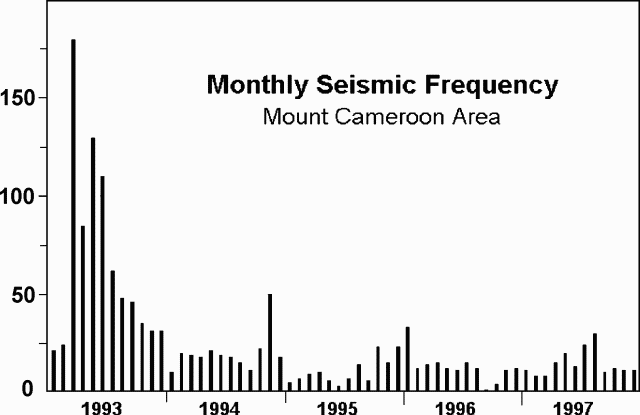Report on Cameroon (Cameroon) — February 1998
Bulletin of the Global Volcanism Network, vol. 23, no. 2 (February 1998)
Managing Editor: Richard Wunderman.
Cameroon (Cameroon) 1997 seismicity remains low with one earthquake swarm
Please cite this report as:
Global Volcanism Program, 1998. Report on Cameroon (Cameroon) (Wunderman, R., ed.). Bulletin of the Global Volcanism Network, 23:2. Smithsonian Institution. https://doi.org/10.5479/si.GVP.BGVN199802-224010
Cameroon
Cameroon
4.203°N, 9.17°E; summit elev. 4095 m
All times are local (unless otherwise noted)
Local seismicity in the Mt. Cameroon region has remained consistently low from 1995 through 1997 at an average of 15 events/month (figure 2). An earthquake swarm recorded in January 1996 consisted of 33 events (modified from BGVN 22:02). Another swarm, of 30 earthquakes, occurred in August 1997. All of the recorded signals were A-type volcanic earthquakes under M 3. Many seismic stations remain out of order and in need of repair, so there is the possibility that other data were lost. However, no events were felt by local residents.
 |
Figure 2. Monthly seismicity in the Mt. Cameroon region, 1993-97. Note that the number of seismic stations functioning varied over the interval shown. Courtesy of IRGM/ARGV. |
Geological Summary. Mount Cameroon, one of Africa's largest volcanoes, rises above the coast of west Cameroon. The massive steep-sided volcano of dominantly basaltic-to-trachybasaltic composition forms a volcanic horst constructed above a basement of Precambrian metamorphic rocks covered with Cretaceous to Quaternary sediments. More than 100 small cinder cones, often fissure-controlled parallel to the long axis of the 1400 km3 edifice, occur on the flanks and surrounding lowlands. A large satellitic peak, Etinde (also known as Little Cameroon), is located on the S flank near the coast. Historical activity was first observed in the 5th century BCE by the Carthaginian navigator Hannon. During historical time, moderate explosive and effusive eruptions have occurred from both summit and flank vents. A 1922 SW-flank eruption produced a lava flow that reached the Atlantic coast, and a lava flow from a 1999 south-flank eruption stopped only 200 m from the sea. Explosive activity from two vents on the upper SE flank was reported in May 2000.
Information Contacts: Ateba Bekoa and Ntepe Nfomou, IRGM Antenne de Recherches Geophysiques et Volcanologiques (ARGV), P.O. Box 370, Buea, Cameroon; G.E. Ekodek and J.M. Nnange, Institut de Recherches Geologiques et Minieres (IRGM), P.O. Box 4110, Yaounde, Cameroon; J.D. Fairhead, Dept. of Earth Sciences, The University of Leeds, Leeds, LS2 9JT, United Kingdom.

